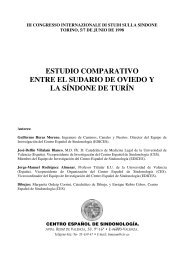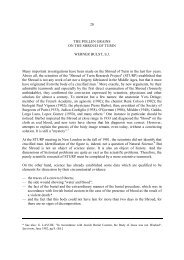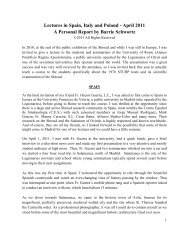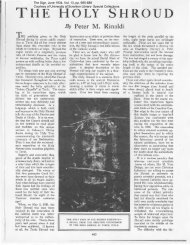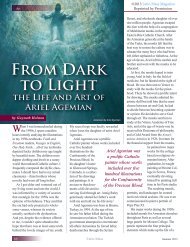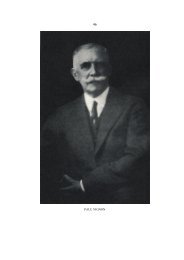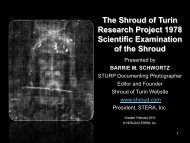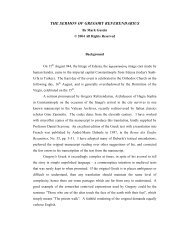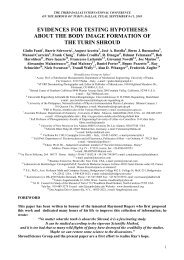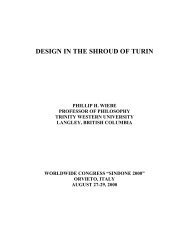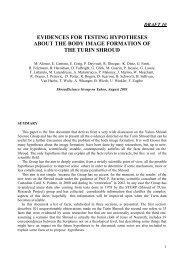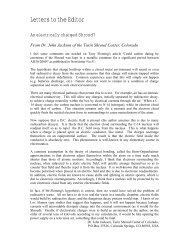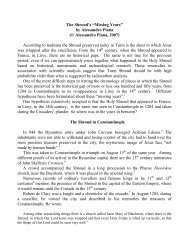the cathar crucifix - The Shroud of Turin
the cathar crucifix - The Shroud of Turin
the cathar crucifix - The Shroud of Turin
Create successful ePaper yourself
Turn your PDF publications into a flip-book with our unique Google optimized e-Paper software.
Languedoc in 1204. I suggest that, upon receiving <strong>the</strong> relic from <strong>the</strong>ir brethren in<br />
Byzantium, <strong>the</strong> Cathars discovered, within its incredible image, irrefutable pro<strong>of</strong> that<br />
Jesus <strong>of</strong> Nazareth had truly been a living human being. Such graphic evidence would<br />
have surely dispelled <strong>the</strong>ir notion that Christ had been only a ghost, caused <strong>the</strong>m to<br />
accept <strong>the</strong> reality <strong>of</strong> his suffering and death on <strong>the</strong> cross, and given rise to <strong>the</strong>ir mortal<br />
dread <strong>of</strong> his <strong>crucifix</strong>ion. I believe that <strong>the</strong> Cathars’ claim to possess <strong>the</strong> body and blood <strong>of</strong><br />
Christ, which simply could not have referred to transubstantiated bread and wine, was<br />
made in reference to an imaged cloth that, when lifted up and unfolded by <strong>the</strong>ir priest,<br />
manifested a mysterious representation <strong>of</strong> Christ crucified.<br />
So too is <strong>the</strong> Cathar <strong>crucifix</strong> to be understood and explained. While modern<br />
sindonologists are cognizant <strong>of</strong> medical evidence indicating that Christ’s arms were<br />
extended horizontally and appreciate that <strong>the</strong> <strong>Shroud</strong> image mirrors <strong>the</strong> position <strong>of</strong> <strong>the</strong><br />
body it once enveloped, thirteenth-century Cathars were ignorant <strong>of</strong> such medical<br />
considerations and probably failed to perceive <strong>the</strong> reverse perspective characteristics <strong>of</strong><br />
<strong>the</strong> image. 89 I suggest that, convinced by <strong>the</strong> sindonic image that Jesus had been crucified<br />
with his hands nailed above his head, his crossed feet affixed by one nail, 90 and his left<br />
side pierced, <strong>the</strong> Cathars created a <strong>crucifix</strong> with no patibulum, three nails, and a wound to<br />
<strong>the</strong> left side.<br />
In his classic study <strong>of</strong> <strong>the</strong> medieval Inquisition, Charles Henry Lea concluded that<br />
<strong>the</strong> Cathar <strong>crucifix</strong> was employed to proselytize orthodox believers. 91 This was based<br />
upon Lucas’ report that <strong>the</strong> heretical <strong>crucifix</strong> had been employed to confuse <strong>the</strong> Catholic<br />
laity 92 and make <strong>the</strong>m question <strong>the</strong>ir faith. 93 Lucas also related, however, that <strong>the</strong> Cathars<br />
attempted to propagate <strong>the</strong>ir heretical beliefs through paintings <strong>of</strong> <strong>the</strong> Holy Trinity that<br />
9



